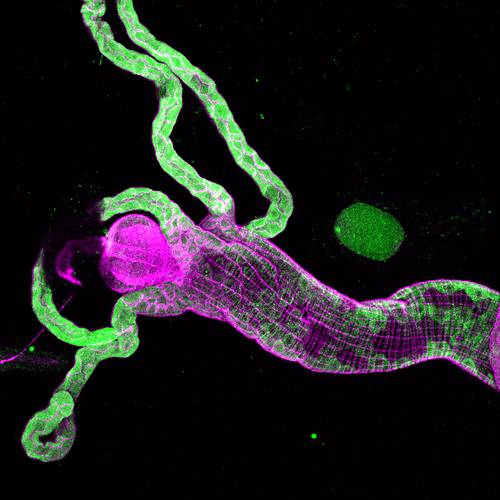
Fluorescence microscopic image of a fruit fly gut. The signaling protein Hedgehog is marked in green, the cell membrane in magenta.
Growth and development are dependent on the availability of nutrients. Nevertheless, some organisms live and thrive even under the most adverse conditions, like scarcity of nutrients. The reason: A complex network coordinates the function of organs and reacts to a shortage of nutrients by maintaining basic cell functions and delay growth and development processes that require a lot of energy. Little is known about how these networks actually function.
Researchers at the Max Planck Institute of Molecular Cell Biology and Genetics (MPI-CBG) have identified the gut as a puzzle piece in this network. The gut regulates the production of a new form of the signaling protein Hedgehog in the fruit fly Drosophila. When food is scarce, Hedgehog signals the fat body - a fruit fly organ – to slow down the general growth and to mobilize energy in the form of stored fats. At the same time Hedgehog manages to tell the prothoracic gland to halt developmental progression. In that way, the fly larvae manages to survive long enough to find new sources of food. Then, the larvae can develop further, although delayed. Moreover, in this study the scientists could show fort he first time that Hedgehog travels far distances between organs and not just within tissues. (Genes & Development, December 2014
Jonathan Rodenfels, Oksana Lavrynenko, Sophie Ayciriex, Julio L. Sampaio, Maria Carvalho, Andrej Shevchenko, Suzanne Eaton
Production of systemically circulating Hedgehog by the intestine couples nutrition to growth and development.
Genes Dev. December 1, 2014 28: 2636-2651
doi: 10.1101/gad.249763.114